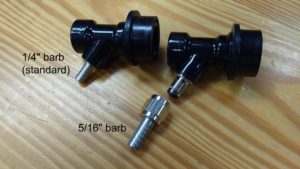Bouncer Hacks
Interesting uses for Bouncer filters that you might not have thought about.
Yes, you can use this if you bottle. No it will not filter out the yeast.
The filter that comes with the Bouncer is 20 gauge (915 microns), which will not filter out the yeast.
What does get filtered out:
- larger particles
- hops
- crusty krausen chunks
- clumps of spent yeast
- your stud earring that you dropped in the fermenter 🙂
- smaller particles
- sediment
- proteins
The smaller particles are more effectively filtered as the larger particles build up in the filter.
On some beers, we have seen gelatin-like clear goo line the inside of the filter. This appears to be proteins that stick to the stainless steel mesh. This material was completely invisible to the naked eye in the beer.
Short answer: 125 degrees Fahrenheit.
Long answer: it depends.
We don’t recommend using the Bouncer above 125 degrees Fahrenheit.
We don’t recommend heat sterilizing the Bouncer.
The manufacturer gives these specs:
- 150 PSI at 70 degrees Fahrenheit
- 100 PSI at 125 degrees Fahrenheit
We designed the bouncer for typical home brewing applications. This means:
- low pressure ( less than 20 PSI)
- low temperatures (less than 100 degrees Fahrenheit)
Heat sterilizing may deform the plastic so that the filter would not function.
Keg-to-keg transfer with a Bouncer
This came to us as a question on Amazon from a customer. Here’s the question:
Is there a version with a smaller barb? I’d love to use this as a filter when jumping from keg-to-keg.
I’m not sure of the exact purpose was behind this question, but here are a few things I can think of:
- you have a really trashy beer in a secondary ferment in a keg
- you dry hopped in the secondary in a keg
- you put a bunch of flavoring stuff in secondary ferment in a keg, e.g. raisins, cocoa nibs, coffee, vanilla beans, citrus peels
Whatever the reason, it would be really helpful to be able to quickly filter when transferring from keg to keg.
However, the standard barb on a ball-lock or pin-lock keg quick disconnect is 1/4″. This fits standard beer tubing. But the Bouncer has a 3/8″ barb. So how do you make this work? See the image below.

You can get a threaded keg quick disconnect on which you can put a 5/16″ barb, which fits siphon tubing, which fits the 3/8″ barb on the Bouncer. The 5/16″ barb is not super-tight, but this tubing is not under (much) pressure, so should work fine. If not, a hose clamp would make it work.
This would certainly work under CO2 pressure. However, I believe it would also work gravity-fed. If the source keg is entirely about the target keg, and you could get the siphon started, and you let air into the source keg, this would siphon fine. Elevating the source keg might be a good idea even with the CO2 pressure, since you’d only need to add enough pressure to get the siphon started, and to replace the beer as it flows out.
By the way, threaded disconnects are pretty handy, and might be a good upgrade for your kegerator regardless. It can make line cleaning and replacing a little easier. In my case, I wanted to be able to easily put a commercial keg coupler in place of my disconnect – threaded disconnects were the easy answer.
Here’s a customer picture of their keg-to-keg transfer with the Bouncer:
This is carbon dioxide, not air.
Coming out of the fermenter, your beer is very lightly carbonated. Yeast has been happily munching the fermentables in the wort, producing alcohol and carbon dioxide (CO2). Some of that gets expelled through your air-lock, but some of that also goes into solution in your beer. If you don’t believe, taste a little, and you’ll feel the slight carbonation on your tongue. You’ll also find that when using the Bouncer out of kettle, you won’t see any bubbles in the filter.
When you pass your beer through the stainless steel mesh on the bouncer, the slight turbulence causes that CO2 to come out of solution. And since the bouncer is a closed filter, that CO2 is trapped in the filter.
Depending on the beer (gravity, yeast, malt bill, hops, etc.) this can be quite noticeable, and on a slowly flowing siphon, can actually cause you to lose the siphon. This happens more often when the CO2 bubble gets large. To lessen those chances, periodically lift the Bouncer so that the inlet/outlet are horizontal, and the CO2 bubble will be drawn through the siphon.
What about oxidation? Well, since CO2 is getting trapped in the closed filter, it also means that air is NOT getting into the filter. So, using the Bouncer will not increase oxygen in your beer.
However, oxidation of your beer out of the fermenter is a real thing, and can significantly change the taste of your beer. You should still try to minimize it by:
- Try not to splash the beer as it flows into your bottling bucket, keg, secondary, or other target vessel. It helps to have a tube that extends to the bottom of your target vessel.
- If you have a CO2 tank, add some CO2 to your target vessel. It is heavier than air and will create a layer of CO2 on the beer which will act as a barrier to the oxygen in the air.
- If you are racking into a keg, “burp” the keg by adding CO2, then using the pressure release. Do this several times. This will help purge the keg of the remaining air, replacing it with Co2.
